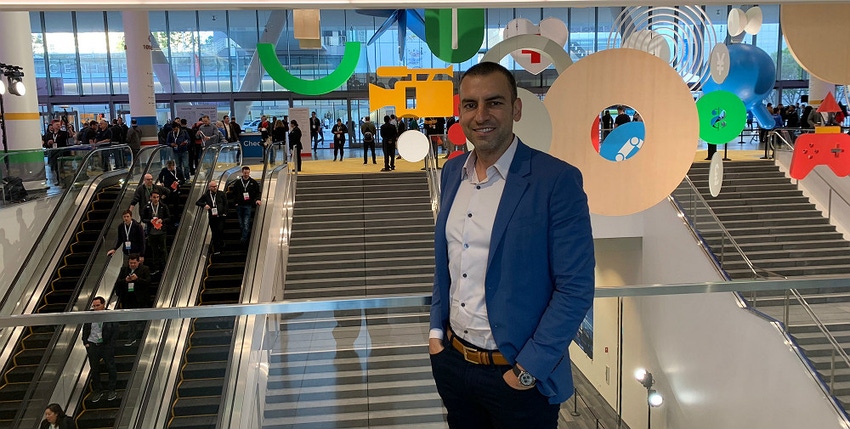SADA CEO Tony Safoian explains his decision to cast aside Microsoft's cloud business to focus on Google.
April 17, 2019

(Pictured above: SADA Systems’ Tony Safoian at Google Cloud Next ’19 in San Francisco.)
While Microsoft services were SADA Systems’ bread and butter for much of its 19-year history, the managed cloud service provider has gone all Google.
The company last month sold its Microsoft business to Core BTS, a cloud services provider held by Garden City, New York-based private equity firm Tailwind Capital after deciding to focus on Google Cloud and its adjacent ecosystem. A few years ago, such a move didn’t appear likely, but recently SADA’s Google Cloud business became more dominant.
SADA had built its business for nearly 20 years as a Microsoft partner offering managed Exchange hosting and ultimately its cloud services. The company was among the first to offer managed Office 365 services and related Microsoft application services, though SADA also was a launch partner for Google Apps, now a G Suite offering, in 2007.
Tony Safoian, SADA’s president and CEO, said that in recent years the company had added much of the Google Cloud Platform (GCP) to its G Suite managed services portfolio. Its Google Cloud business ultimately became larger than its Microsoft-based service offerings.
Although SADA had kept the Google and Microsoft sales and support lines of the businesses siloed – even operating on different floors of its headquarters in Los Angeles – Safoian said the company faced the decision of trying to expand both groups, or to go with a single cloud-provider ecosystem strategy. Safoian began exploring various options more than a year ago.

SADA Systems’ Tony Safoian
“As I looked at the next five years, there were a couple of different paths we could have chosen,” Safoian told Channel Futures during an interview at last week’s Google Cloud Next 2019 conference in San Francisco. “One was to diversify and become truly agnostic and maybe pick up other cloud providers, or the other path, which we felt was more up our alley and more to our natural strengths — … to partner even closer with one and we picked Google Cloud.”
SADA is now a Google Cloud Premium partner, the highest partnership tier Google offers. Asked if he considered going the other route, and focusing just on his Microsoft business, Safoian said there were various reasons why choosing Google Cloud made more sense. Most notably was the opportunity to stand out more prominently in the Google Cloud partner ecosystem versus the crowded Microsoft Partner Network.
“I think us executing in a smaller ecosystem was easier for us to be more distinguished,” Safoian said. “On the Google side, we often engage in the Fortune 500, something that’s started to accelerate. And the Microsoft ecosystem is so large with so many very large partners including Accenture, Avanade, MCS, Deloitte and many others, that it became hard for an 85-employee, $125 million Microsoft partner to even be invited to play in that enterprise ecosystem.”
Given the shift and signs of what Safoian sees as Google Cloud’s potential growth, the decision was made to jettison the Microsoft managed services business.
“We decided that we should leverage the momentum that we have to go on this journey with Google and with [Google Cloud’s new CEO Thomas Kurian] and see what the next five to 10 years and beyond brings,” he added.
As an underdog to the larger Amazon Web Services and Microsoft cloud services, SADA’s decision as a major endorsement of Google Cloud from a partner perspective, said channel chief Nina Harding.

Google Cloud’s Nina Harding
“That’s a proof point of the momentum that we have,” she said.
Safoian said the pivots that former Google Cloud CEO Diane Greene made to the business and the company’s partner-led sales focus convinced him that the move was a sound bet.
“I think we have a tremendous runway ahead,” he Safoian said. “We can continue to grow 30-40, 50-percent per year, for the next five years. I just don’t see many barriers to us doing that, outside of our own execution and creativity. There’s just more demand today,for Google Cloud than all the partners combined can deliver. I just don’t see the market slowing down in terms of demand … the onus is on us to execute really well [and] hire the best people.”
Google last week recognized SADA’s commitment, naming it as its 2018 Global Partner of the Year, based on its growth in …
… offering enterprise GCP services, including G Suite, Maps and enterprise search and customer growth. Among some of SADA’s large clients that have started adopting Google Cloud services are Colgate-Palmolive, Hunterdon Healthcare, Media News Group, Hackensack Meridian Health and Marriott. SADA has also expanded its public sector service offerings with customers, including the Chicago Department of Transformation and the State of Arizona.
Despite SADA’s decision, Safoian said Microsoft was supportive of the move.
“It’s great for our former Microsoft business to be untethered from our bigger Google focus,” he said.
SADA’s former Microsoft business gives Core BTS an expanded West Coast presence. Core BTS has 16 offices throughout the U.S. and provides design, implementation and managed services for more than 1,200 customers.
Ironically, during its heyday offering Microsoft-related managed cloud services, Safoian believes it was SADA’s early experience offering Google Apps that helped it succeed with managed Office 365 services and its predecessor, BPOS.
“That’s actually what made our Microsoft business successful in the cloud with Microsoft,” he said. “We understood the business model and we were all in.”
Read more about:
MSPsAbout the Author(s)
You May Also Like


